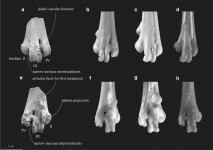Fred Ruhe
Well-known member

Cheng-Hsiu Tsai & Gerald Mayr, 2021
A phasianid bird from the Pleistocene of Tainan: the very first avian fossil from Taiwan
Journal of Ornithology (advance online publication)
doi: https://doi.org/10.1007/s10336-021-01886-w
https://link.springer.com/article/10.1007/s10336-021-01886-w
Free pdf:
https://link.springer.com/content/pdf/10.1007/s10336-021-01886-w.pdf
Abstract:
Taiwan accommodates more than 600 avian species, including about 30 endemic ones. As yet, however, no fossil birds have been scientifically documented from Taiwan, so that the evolutionary origins of this diversified avifauna remain elusive. Here we report on the very first fossil bird from Taiwan. This Pleistocene specimen, a distal end of the left tarsometatarsus, shows diagnostic features of the galliform Phasianidae, including an asymmetric plantar articular facet trochlea metatarsi III. Our discovery of a Pleistocene phasianid from Taiwan opens a new perspective on studies of the evolution of the avifauna in Taiwan because the fossil shows that careful search for fossils in suitable localities has the potential of recovering avian remains. In general, East Asia has an extremely poor avian fossil record, especially if terrestrial birds are concerned, which impedes well-founded evolutionary scenarios concerning the arrival of certain groups in the area. The Phasianidae exhibit a high degree of endemism in Taiwan, and the new fossil presents the first physical evidence for the presence of phasianids on the island, some 400,000â800,000 years ago. The specimen belongs to a species the size of the three larger phasianids occurring in Taiwan today (Syrmaticus mikado, Lophura swinhoii, and Phasianus colchicus). Still, an unambiguous assignment to either of these species is not possible due to the incomplete nature of the left tarsometatarsus. Because the former two species are endemic to Taiwan, the fossil has the potential to yield the first data on their existence in the geological past of Taiwan if future finds allow identification on species-level.
Enjor,
Fred
A phasianid bird from the Pleistocene of Tainan: the very first avian fossil from Taiwan
Journal of Ornithology (advance online publication)
doi: https://doi.org/10.1007/s10336-021-01886-w
https://link.springer.com/article/10.1007/s10336-021-01886-w
Free pdf:
https://link.springer.com/content/pdf/10.1007/s10336-021-01886-w.pdf
Abstract:
Taiwan accommodates more than 600 avian species, including about 30 endemic ones. As yet, however, no fossil birds have been scientifically documented from Taiwan, so that the evolutionary origins of this diversified avifauna remain elusive. Here we report on the very first fossil bird from Taiwan. This Pleistocene specimen, a distal end of the left tarsometatarsus, shows diagnostic features of the galliform Phasianidae, including an asymmetric plantar articular facet trochlea metatarsi III. Our discovery of a Pleistocene phasianid from Taiwan opens a new perspective on studies of the evolution of the avifauna in Taiwan because the fossil shows that careful search for fossils in suitable localities has the potential of recovering avian remains. In general, East Asia has an extremely poor avian fossil record, especially if terrestrial birds are concerned, which impedes well-founded evolutionary scenarios concerning the arrival of certain groups in the area. The Phasianidae exhibit a high degree of endemism in Taiwan, and the new fossil presents the first physical evidence for the presence of phasianids on the island, some 400,000â800,000 years ago. The specimen belongs to a species the size of the three larger phasianids occurring in Taiwan today (Syrmaticus mikado, Lophura swinhoii, and Phasianus colchicus). Still, an unambiguous assignment to either of these species is not possible due to the incomplete nature of the left tarsometatarsus. Because the former two species are endemic to Taiwan, the fossil has the potential to yield the first data on their existence in the geological past of Taiwan if future finds allow identification on species-level.
Enjor,
Fred




